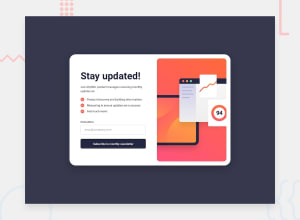
Submitted 9 months ago
Newsletter Sign Up using sass and css flexbox
#accessibility#itcss
P
@danielbasilio
Design comparison
SolutionDesign
Solution retrospective
What are you most proud of, and what would you do differently next time?
I'm very proud of the responsive layout made using CSS grid. In the future I would focus on improving the separation of components within sass
What challenges did you encounter, and how did you overcome them?The project as a whole was quite challenging. It took me a long time to finish, as I am a beginner in React. I had to study the framework throughout all stages of development.
What specific areas of your project would you like help with?I believe that the entire architecture can be improved.
Community feedback
Please log in to post a comment
Log in with GitHubJoin our Discord community
Join thousands of Frontend Mentor community members taking the challenges, sharing resources, helping each other, and chatting about all things front-end!
Join our Discord
